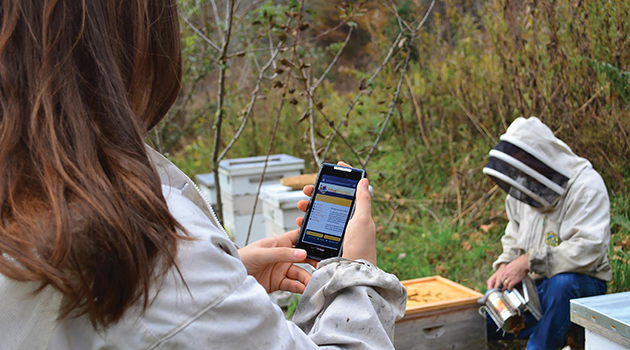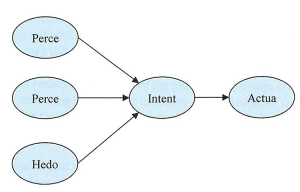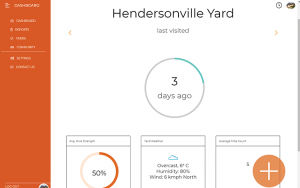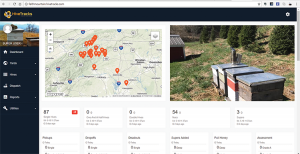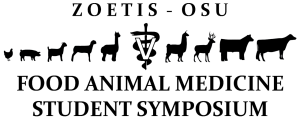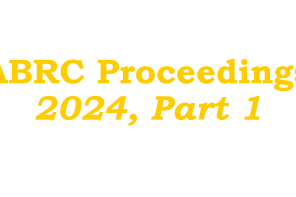By: Joseph Cazier, James Wilkes, Edgar Hassler
Introduction
 In the April issue of Bee Culture we introduced the concept of a Genius Hive. Then in the May issue we made the case for keeping electronic records as a path to better beekeeping. Now we want to discuss efforts to encourage beekeepers to adopt helpful technologies with the application of the Technology Acceptance Model (TAM) to electronic record keeping software like HiveTracks.
In the April issue of Bee Culture we introduced the concept of a Genius Hive. Then in the May issue we made the case for keeping electronic records as a path to better beekeeping. Now we want to discuss efforts to encourage beekeepers to adopt helpful technologies with the application of the Technology Acceptance Model (TAM) to electronic record keeping software like HiveTracks.
The Technology Acceptance Model is based on one of the oldest theories developed in the field of Information Systems and is perhaps the most widely studied area in the discipline. While there are newer extensions of TAM, such as the Unified Theory of Acceptance and Use of Technology (UTAUT), we believe that TAM is a better fit for thinking about bees and beekeeping due to its simplicity and to its having withstood the test of time, since Fred Davis1 introduced it to the discipline in 1989.
In the next sections we will discuss what the Technology Acceptance Model is, why we need a framework like this one, and how we are using it at CARE (The Center for Analytics Research and Education at Appalachian State University) and at HiveTracks to help today’s beekeepers.
The Technology Acceptance Model
The technology acceptance model was developed as an early theoretical model to measure differences in the rates of acceptance of some of the technologies entering the marketplace. Recall that at this time (in the late 1980s), few people had access to the Internet, email, or the other applications we take for granted today. Therefore, most of the technology was only being used by midsize to large organizations to help them scale and run their operations more efficiently.
These systems were mostly being developed to help people do better at work and were very task-focused. However, most of the individuals comprising the workforce at the time had little exposure to information technologies and it was difficult for many of them to adjust. Many projects were rejected by workers and failed, resulting in wasted development efforts and lost opportunities.
Given these challenges, academics, and others began a systematic study of the factors that influence user adoption of information technologies in a business context. The two constant factors for the acceptance of work-related information systems are Ease of Use and Usefulness2, e.g. the greater a person perceived a system as easy to use and/or useful, the greater the likelihood that he/she planned on using the system3 at work.
One advantage was that most systems were employer-based and management could tell people to use the system. This made it easier to get people that had never used (or seen) a system to try using it. However, Ease of Use and Usefulness were still very important in determining their ability to follow through.
Several decades later, after systems migrated out of factories and offices, we added an extension to this theory. This concept was called Hedonism, based on a worldview espoused by Aristippus of Cyrene, a student of Socrates, who held the idea that pleasure is the highest good.4
Due to its history and the advent of more consumer oriented technologies, the concept of a Hedonic Information System was added to the theory by Van der Heijden (2004)5 to account for consumer enjoyment in systems they use. Today, most people commonly refer to it as the degree of pleasure or enjoyment people derive from using an information system (see Fig. 1).
Thus, the modified or updated Technology Acceptance Model, as we have chosen to use it, is based on these three concepts: Ease of Use, Usefulness and Enjoyment. As the perceptions of any of these factors increase, people are more likely to adopt and use the information system. Sure, other factors such as price, relevance, and accessibility can be relevant, but those are general business issues. This framework focuses on users incorporating the system to their regular work and life patterns after they acquire a system.
In the next section we will discuss why we need a framework like this to build better information systems.
Why We Need a Framework Like TAM
One might ask why we need a system like this and how we can use it. In retrospect, the factors seem obvious enough, though they were less obvious when developed. It can also seem rather simplistic. However it has largely proven itself, with nearly 30 years of research to back it up.
Obvious or not, keeping these factors (Ease of Use, Usefulness and Enjoyment) in mind while developing software systems brings discipline to the software development process. There are always more features that can be added, more tools to try, more complexity to include. Without discipline, it is easy for software and information systems to become bloated, cluttered, or unappealing, and then adoption and usage rates decline.
However, having a framework, even a simplified one like this, sharpens the focus and greatly aids in the software development process. In fact, a simplified system like this one is sometimes better in practice as it helps bring the attention to the few things that really matter: in this case, the three factors mentioned above.
A developer might use this framework in team settings and other meetings to prioritize which possible features to add (and which current features to modify or drop). Additionally features can be ranked on how much they will help or hurt ease of use, usefulness, or enjoyment.
This task can be done in a variety of ways. One of the most common ways is to give each feature a score, say from 1 to 10, indicating how much it improves each of the three factors, then aggregating the results, and prioritizing those that add the most value per unit of effort. Once they are added or prototyped, user feedback can be sought and adjustments made before rollout.
This is the type of process we just went through for our HiveTracks hobbyist and commercial platforms. We will share some of the highlights of the new systems in the next section.
How we are using TAM at HiveTracks
Since the genesis of our first prototype hive management software in 2009, HiveTracks has been in a constant development cycle of evaluation and update, responding to user feedback, technology changes, and market demands. In recent years, a recurring message from our users goes something like this, “I love the software and the idea of keeping good records, but I don’t use it like I should!” One result of this mindset is inconsistent and incomplete data collection, which makes data analytics challenging. You can see where TAM can help, and we have completed a comprehensive review of the software and are in a sequence of updates using the principles of TAM as a guide. In this section we will give an overview of the software updates we are making.
Hobbyist Platform
If you have ever used HiveTracks, you know the comprehensive nature of the software with its rich feature set and extensive functionality. However, only the most dedicated and disciplined record keepers use the software to its full potential. For most beekeepers it is overwhelming, and they are disappointed and apologetic for not using it like they think they should. We want to change that sentiment.
It is tricky business to redesign an existing software platform, using TAM principles rather than starting over, but at least, for now, that is what we are doing (see Fig. 2). What follows are a few of the recent changes categorized by TAM principles.
Ease of Use
Using a computing device in the bee yard, a hostile environment for technology, is relatively new territory for beekeepers and detailed data entry is a non-starter for most, but we believe it is critical that bee data must be collected as close to the source as possible. The bigger the time gap between observations in the yard and data entry, the bigger the risk of not getting good data or any data at all! Our ease of use changes focus by offering a simple, clean, mobile first user interface design and requiring the fewest number of clicks to get the most valuable data (the second TAM principle).
Usefulness
The immediate utility of HiveTracks is found in the information it can deliver to beekeepers when they need it to make good management decisions. What information is most useful to individual beekeepers? What is most useful to the beekeeping community? What is the minimum amount of data each beekeeper should record to get the most value? Lining up these answers is an optimization problem that we are still working on, but the obvious place to start is to record when you visit a yard. If nothing else, this will help you be more regular in checking your bees and improve your beekeeping. Next is knowing what you did the last time you visited the bee yard and what you observed. Both of these bits of information are essential to knowing what follow-up actions are needed and what you expect to see on the next inspection, e.g., if there was a virgin queen on the last visit, you better come back soon and make sure she has mated and is laying well. Our current update brings these items front and center for the user along with the Healthy Colony Checklist6 as a quick and informative standard for colony health assessment and Varroa mite load monitoring. Of course, the list of useful information is almost endless, but the ongoing questions are what is the most important information and what is worth the time to collect? Stay tuned as HiveTracks continues to shine light on these questions.
Enjoyment
Anyone who has spent much time with honey bees enjoys being in the bees, so being able to extend that enjoyment outside the bee yard is a benefit of HiveTracks. Looking at pictures taken during a yard visit, entering more detailed records and notes in the comfort of your home, and evaluating graphs showing trends in health and production are all ways to connect with your bees outside the bee yard. In addition, the community feature of HiveTracks allows bee clubs and classes, beekeeping friends, and mentors and mentees to share hive information and compare it with others within the application. More social media and gamification ideas are in the works and will further extend the enjoyment options.
Commercial Platform
The commercial beekeeping sector has always shown an interest in the hivetracks.com application and several have used that platform to meet their needs over the years. However, the feedback from most commercial keepers, beginning five years ago, was that they recognized the need for better record keeping, but the required level of detailed data entry would not work in their fast-paced production environment. Furthermore, the current methods most commercial beekeepers adopt for recording yard locations, counts of hives, and management actions use very little technology in both the collection and storage of this data. Based on these factors, we spent two bee seasons designing and building a commercial platform based on a minimalist and ease of use approach, as the only pathway to getting acceptance and use and managing costs. Custom software systems for each beekeeper could work, but are very expensive and difficult to create with software companies that do not understand beekeeping. Many have tried and continue to do so, but our approach is to maintain an agile software framework that is easy to use and useful, while maintaining reasonable costs and flexibility to adapt to new technologies as well as the changing needs of beekeepers.
Following is a brief overview of the HiveTracks Commercial system from the TAM perspective. Note that the system is comprised of a web application that houses the data and offers various reporting and communication features and a mobile app for collecting data in the field.
Ease of Use
For the commercial beekeeper who is managing multiple crews in a distributed work environment that is dynamic and unpredictable, ease of use is a top priority as the field level workers are the ones who must enter data. If crews cannot enter the data quickly and easily within the existing workflow process, the software will not be used. Our commercial mobile app has a super simple interface with predefined options (yards, previous hive counts, purpose of yard visit, feed lists, treatment options) that require only a few clicks for data collection, but also give the option for free form comments and the inclusion of images from mobile phones/tablets. Another issue is language as many workers are not native English speakers, so Spanish language versions of the app are in use. Finally, despite advances in cell phone networks, connectivity remains an issue in many yard locations, so offline capability is now part of the ease of use and is built into the mobile app. Although we have focused on the mobile app here, the web application is also designed for ease of use and provides key hive counts, management actions, images, and maps in a dashboard setting for the owner and staff (see Fig. 3).
Usefulness
Commercial beekeeping is a business and any technology solution has to provide benefit to the bottom line, which means the value added or efficiency gained must be significantly more than the cost of the software. Use cases that clearly demonstrate the benefits are numerous and range from less time required by owners to collect and synthesize daily crew reports for planning the next day’s tasks to not forgetting yards in a round of treating/feeding or moving. More timely and accurate information is a key element when adding technology to the beekeeping operation and is achieved by the combination of the mobile app in the field delivering data in real time to the web application. An added operational benefit is the software allows broader access to key metrics, getting important information out of owner’s head/hands and to the crews on the ground to assist them in making decisions. This eliminates the time an owner uses to spend communicating these metrics while allowing him/her to still see what is happening. We have only scratched the surface of the value of the software, but can already demonstrate the return far outstrips the investment. We will continue to document and share the benefits as our commercial users gain more experience and find creative uses, which beekeepers are good at doing.
Enjoyment
One could argue that enjoyment is not a high priority for commercial beekeeping software, but there is definitely an element of satisfaction/pride for everyone in the commercial operation when they can see the colony counts in the operation on a graph and the images from the bee yards, visualizing the progress made each day by the crews in real time. Even crew members entering the data gain a sense of inclusion in the business operation and take greater ownership of their role and are empowered to make better decisions with access to information not previously available.
Conclusion
Our goal is to help beekeepers take advantage of the benefits that technology has to offer, eventually leading to the development and use of the Genius Hive. One important step on that path is to develop software that people will use to collect and manage their data in a way that can be analyzed to help beekeepers everywhere.
It is our hope that these software updates, based on the principles of TAM, will make our software easier to use, more useful, and more enjoyable for today’s beekeepers. There is still more to do, but hopefully these updates will help nudge beekeepers into the future today. If it has been a while since you checked us out, please visit hivetracks.com to review the updates and let us know what you think.
Finally, special thanks to Project Apis m. for supporting a portion of this work with a Healthy Hives 2020 grant and to Bee Culture for providing a venue for sharing these ideas with an interested audience.
Special thanks to Ryann-Rebecca Montgomery and Kiefer Smith, for their help in shaping some of the ideas behind this article and to Wendy Winn for her help with technical editing.
Joseph Cazier is the Chief Analytics Officer for HiveTracks and the Director of the Center for Analytics Research and Education at Appalachian State University. He spends his days thinking about ways to use analytics for good and then finding ways to do them. You can reach him at joseph@hivetracks.com
James Wilkes is the Founder and CEO of HiveTracks. and a Computer Science Professor at Appalachian State University. His lifelong passion for bees keeps fueling the development and mission of HiveTracks software. You can reach him at james@hivetracks.com.
1Davis, F. D., Bagozzi, R. P., & Warshaw, P. R. (1989). “User acceptance of computer technology: A comparison of two theoretical models”. Management Science, 35, 982-1002.
2Technically it is perceived ease of use and perceived usefulness. However I have shortened it to the essential elements for readability.
3In academic speak, we call these behavioral intentions – in this case the intention to use and adopt a system.
4https://en.wikipedia.org/wiki/Hedonism
5Van der Heijden, H. (2004). “User Acceptance of Hedonic Information Systems”. MIS Quarterly, 28 (4), 695-704
6More information on the HCC is available here: https://beehealth.bayer.us/who-can-help/beekeepers/healthy-colony-checklist






